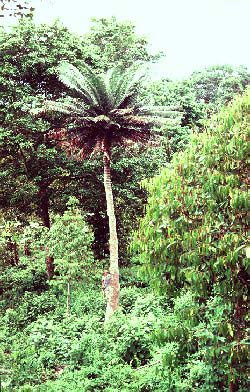
| |
| Cycas macrocarpa | Photo Ken Hill |
 |
|
The very large divided leaves means that cycad plants resemble palms or tree-ferns in overall appearance. Cycads, however, differ greatly in almost all aspects of detailed structure and reproductive behaviour. Cycad plants are dioecious (i.e. male and female reproductive structures are borne on separate plants), and reproduction is by seeds, which are produced on open carpophylls or seed-bearing leaves. Although technically woody plants, unlike other woody plants, cycads possess a pachycaul stem. This is a thick, soft stem or trunk made up of mostly storage tissue with very little true wood. Within the trunk, leaf traces or veins leading to leaves arise at a point opposite the attachment of the leaf, and circle the trunk within the storage tissue. These are known as with girdling leaf traces, and occur in some ferns but no other seed plants. The coralloid roots of cycads are also characteristics not seen in other seed plants, and the cycads lack the axillary buds seen in other seed plants.
The living cycads (division Cycadophyta) include about 250 species, with 11 genera in 3 families. The cycads have been classified as "gymnosperms" in the past, although recent studies have shown that this is not a natural group, some members being closer to the flowering plants than to other "gymnosperms". The "gymnosperms" are all ancient seed plants, many now extinct, but with four major groups living today. These are the cycads (Cycadophyta), the Welwitschia group (Gnetophyta), the conifers (Pinophyta) and Gingkgo, the Maiden Hair Tree (Ginkgophyta). They are now regarded as quite separate and distinct classes of equivalent status to the flowering plants (Angiosperms or Magnoliophyta). Although the four groups of "gymnosperms" are very different from one another in appearance they all produce naked ovules in contrast to the flowering plants in which the ovules are enclosed in an ovary.

| The Cycad Pages © 1998 Royal Botanic Gardens Sydney Written and maintained by Ken Hill Please send comments and corrections |